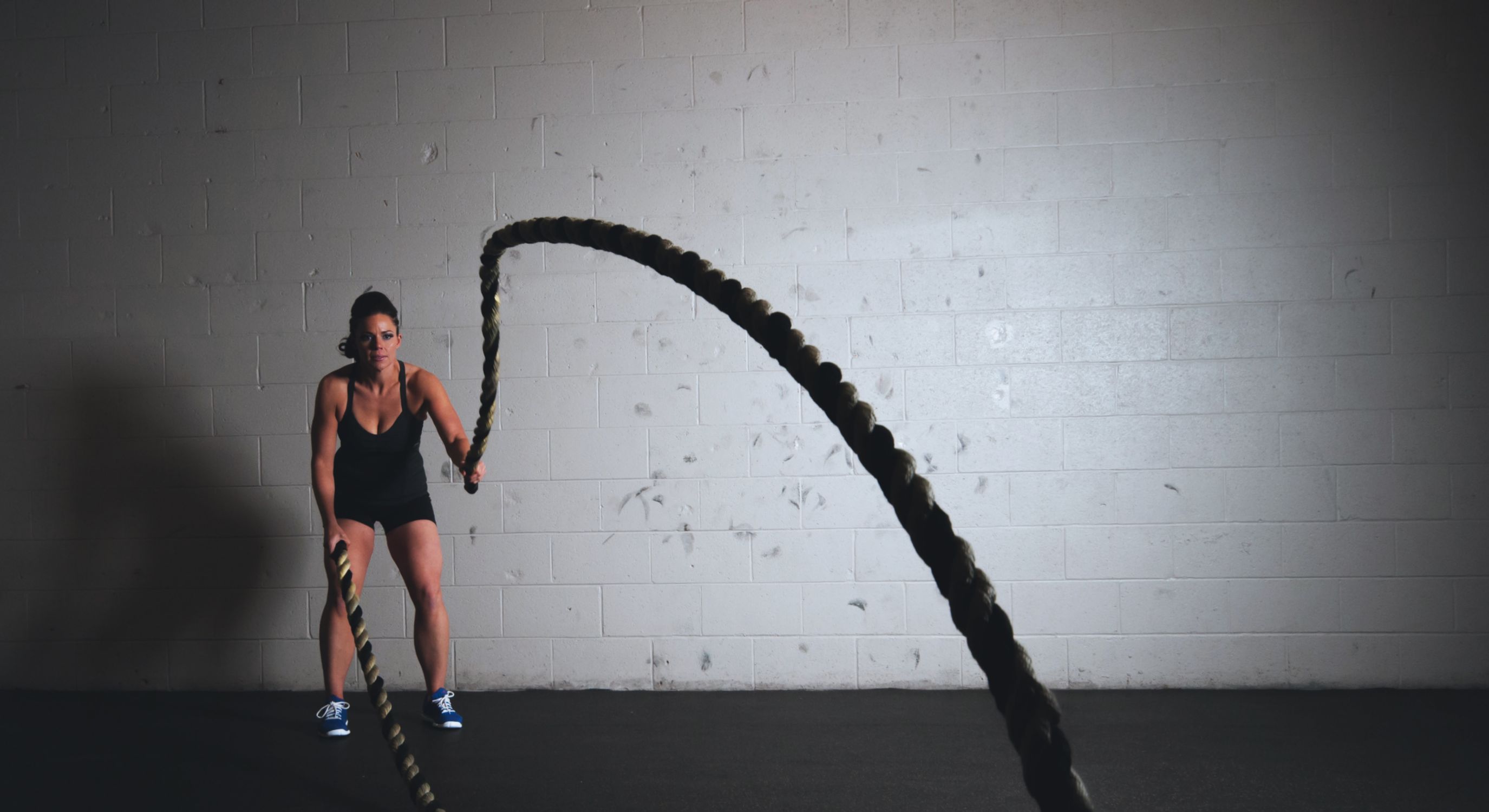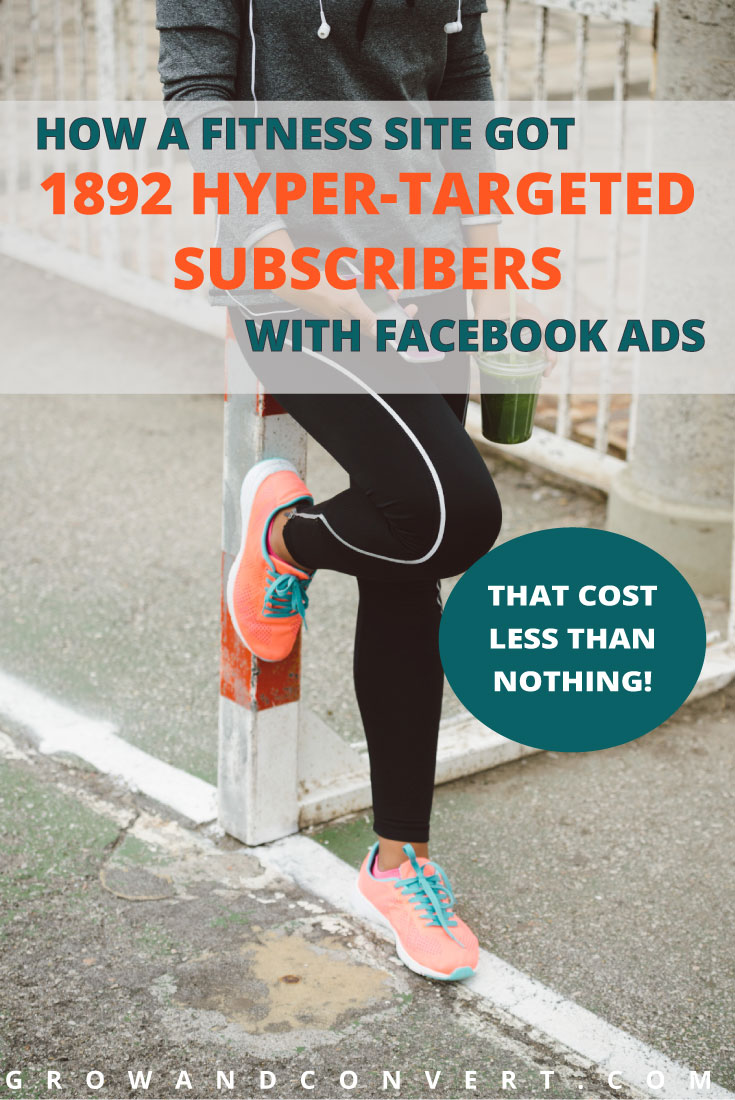Today we’re profiling a fitness site that grew traffic and subscribers with Facebook Ads that made them money.
We’re going to see how Erika of Erika Volk Fitness added 1,892 email subscribers and got 11,850 unique visitors in one month with a Facebook ad campaign that hasn’t cost her a dime. In fact, she’s come out of the campaign ROI positive.
The best part is, Erika did this:
- without any prior Facebook ad knowledge (this was her very first campaign)
- without a massive budget (she started with $20/day)
- without a massive Facebook following (her Facebook page had 551 likes).
Because this is paid advertising driven customer acquisition, these aren’t one off numbers, they’re rates. Until she exhausts her target audience on Facebook, she can continue serving up ads and keep getting results like this month after month.
In true Grow and Convert style, we’re going to walk through exactly what she did, step by step, sharing every single detail and screenshot Erika was willing to share with us.
Let’s start by looking at her results in more detail.
Erika’s Results: 1,892 Email Subscribers and 11,850 Pageviews While Making Money on Facebook Ads
We’ll learn more about Erika and uncover the details of how this campaign was executed shortly, but first let’s see what kind of results Erika Volk Fitness (EVF) got with their Facebook campaign.
Over almost 2 months running the ad EVF received 11,850 unique visitors to their landing page.

Erika didn’t put her Google Analytics snippet onto her Leadpage but to put that in perspective, her main site received 6,484 users in that same time frame
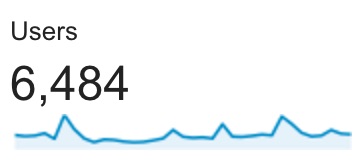
So, that’s a 82% more targeted visitors being exposed to her brand from this campaign.
And did they take action? Yes, 1,892 of them signed up for her email list, for a conversion rate of 16%.
This skyrocketed her email list growth starting in January, when she pushed start on the ads. Here’s a plot of new email subscribers added each month:

For any small business, a step change in an important metric like that (email subscribers in this case) is transformative.
So how much did this traffic and subscribers cost EVF? $492
For 1892 subscribers, that comes out to an unbelievable $0.26 per subscriber.
For anyone who has used Facebook ads to collect leads before, they know this is a low number. (For example, compare this with the 43 cents per subscriber that this marketer got.) Below is more discussion as to why this could be.
But here’s the kicker: These email subscribers were sent through an autoresponder sequence where they could buy one of two full exercise programs.
And some bought almost immediately. To date, Erika has sold $632 of ebooks, enough to pay for the ads, and then some.
So that’s 82% extra traffic per month and 1892 leads into the top of her funnel that cost a net -$140.
And, like I mentioned before, the best part of this is that this isn’t a “one off” campaign. Erika Volk Fitness can continue running these ads for a long time (we’ll look at how long it would take to exhaust their target demographic on Facebook below).
So it’s a steady, predictable, and insanely affordable source of customer acquisition.
Now let’s dive into the meaty details, and start by learning more about Erika and her business.
Let’s meet Erika, owner of Erika Volk Fitness, and Learn Why She Turned to Facebook Ads for More Predictable Growth
Erika runs ErikaVolkFitness.com, a site that helps women with PCOS fight the symptoms, lose weight, and become healthier.
If you don’t know what PCOS is, just know it throws women’s hormones out of balance, so they gain a ton of weight, have a lot of trouble losing it, can often have trouble getting pregnant, get diabetes and heart problems.
In other words, it’s crippling. And the weight gain is a foundational part of the problem.
Erika beat PCOS with an exercise routine she crafted and honed over years, to a point where when she goes to the doctor now, her hormone profile almost show no signs of symptoms.
Her transformation is inspiring:
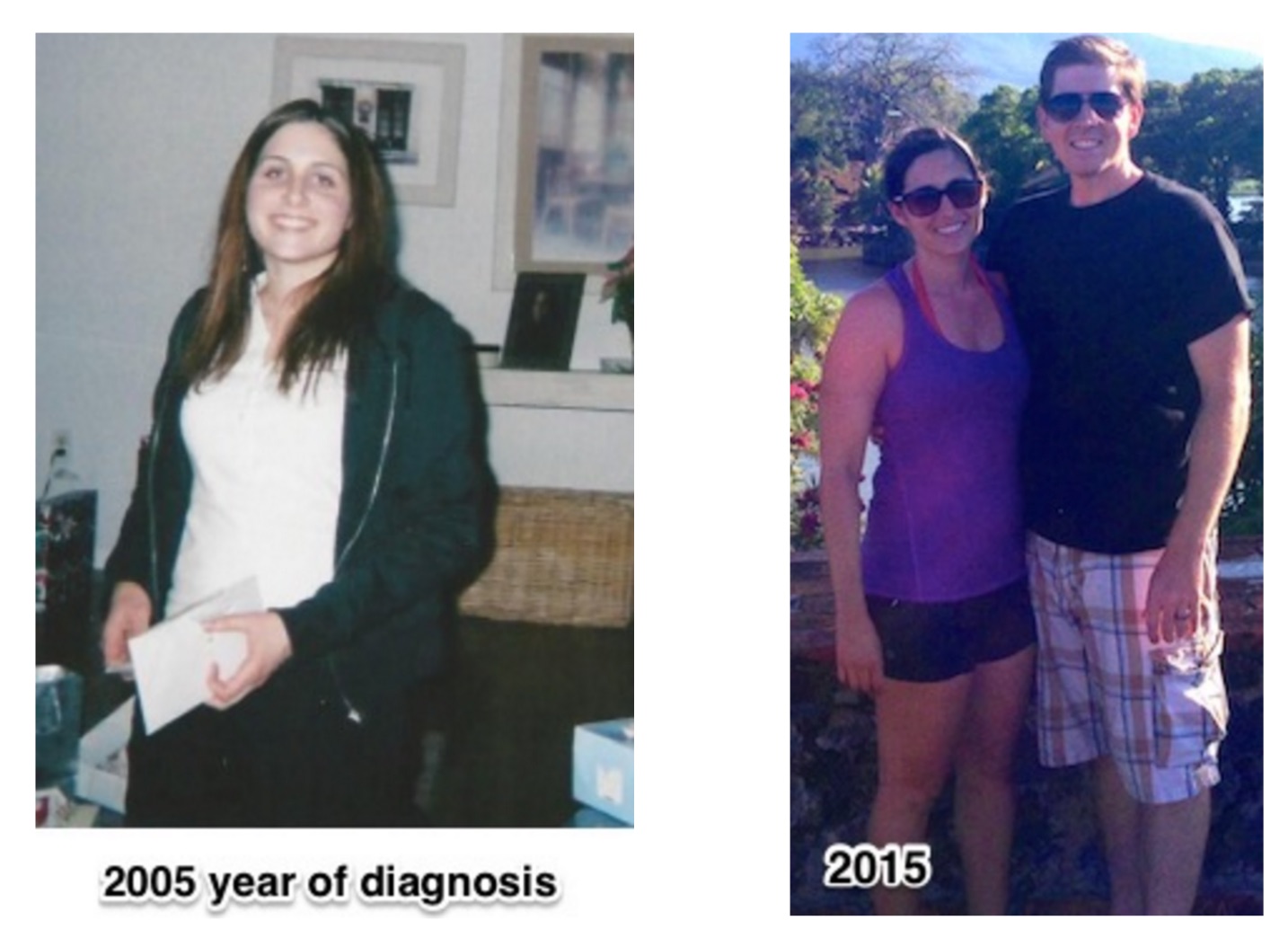
Those photos are impressive for anyone trying to lose weight, but even more impressive when you know she was fighting a hormone altering disease along the way.
Beating PCOS for a woman with the disease is, no exaggeration, life changing.
And that’s what her company, Erika Volk Fitness, is aiming to do: help women beat PCOS just like Erika did:
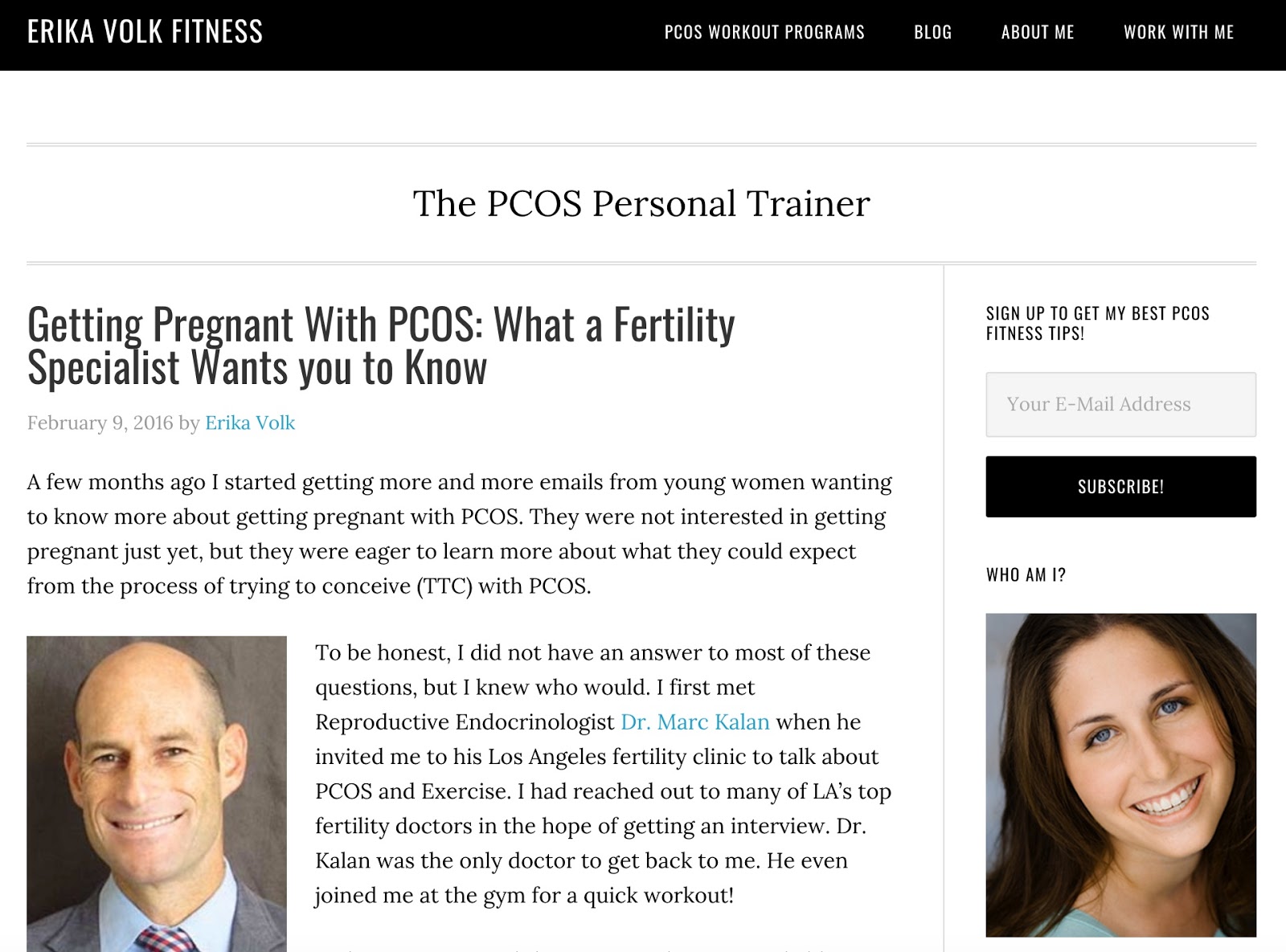
Revenue comes from ebooks, coaching, and (soon) a monthly membership program.
Quite frankly, Erika has a business that many entrepreneurs we’ve talked to aspire to have: make money and genuinely help people at the same time.
Although she spent 1.5 years growing her blog to 6000 monthly uniques and 3596 email subscribers, she wanted a more predictable, steady way to target her ideal customers (women with PCOS) and get them onto her email list (the online channel with the highest engagement, by far).
So, after being inspired by Videofruit’sFacebook Ad Experiment, she decided to give Facebook ads a shot.
The first step, of course, was laying out the funnel.
The Facebook Funnel For Capturing Leads
This was her funnel:
(1) Facebook ad promoting an email course; (2) Linked to a LeadPages landing page; (3) Opting in triggers an 8 email series delivering the material; (4) Occasional upsells during the course for premium workout routines and plans.
We’ll dive into the details of each step and show the creative and the numbers of each step.
Step 1: Facebook Ads
Facebook Ad Creative
This was the Facebook ad creative:
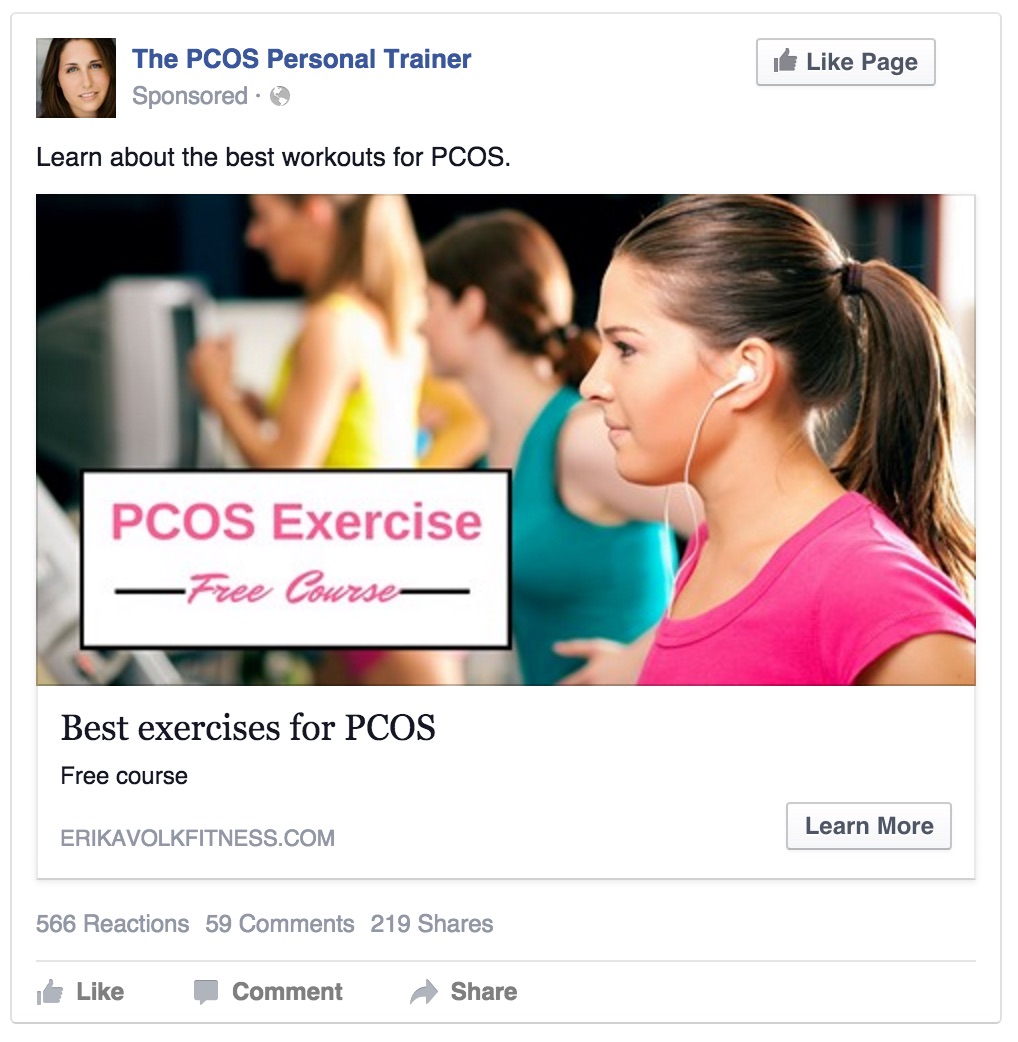
She made the image with Canva for $1.
As a peak into ad performance, which we will discuss shortly, you can see the kind of engagement this ad has received: 566 reactions, 59 comments, and a whopping 219 shares.
The shares are particularly powerful, because every time someone shares your promoted post, it’s exposed to their friends for free. That is, views and clicks on the shared post by the sharer’s friends cost nothing to you.
Facebook Ad Targeting and Budget
She set the ad to display on:
- Desktop news feed
- Desktop right column
- Mobile news feed
- Audience network.
She didn’t include Instagram.
Targeting is critical to her performance. She targeted women ages 24 – 54 with interest in PCOS in a few countries.
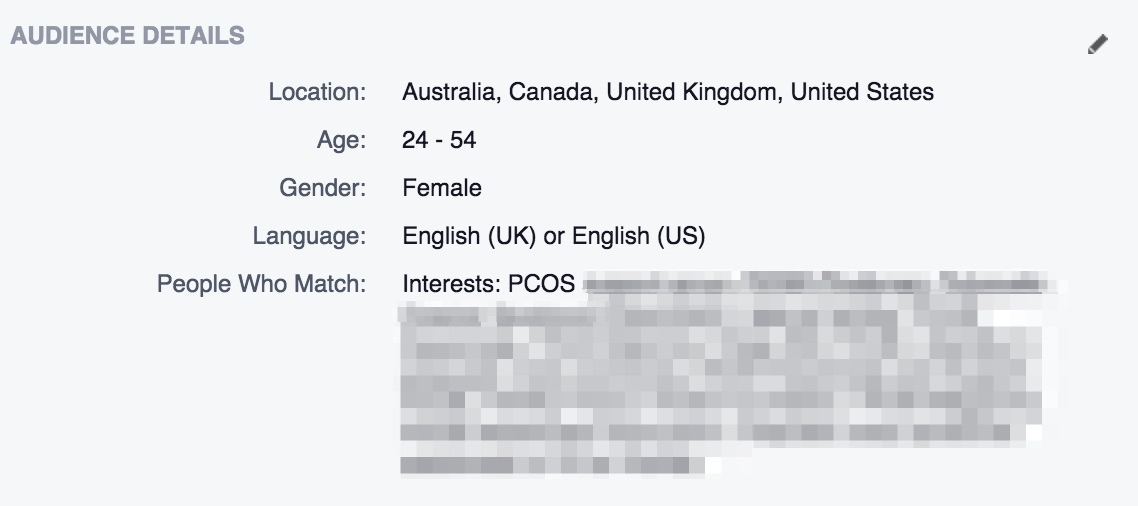
(We’re blurring out her interest categories because she’s worked hard refining that list.)
Her daily budget is $20 per day.
All of this gives her a estimated reach of 730,000, which Facebook characterizes as “fairly broad”.
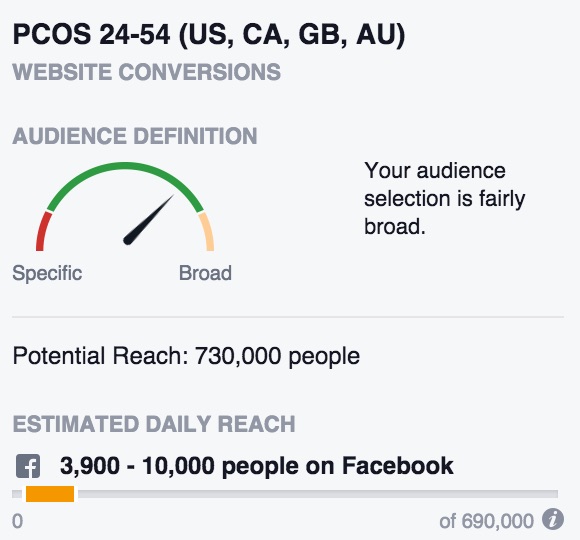
This is interesting to note: the raw number of people in her “Potential Reach” is pretty large from a Facebook ad campaign perspective.
But qualitatively, we know that what she is promoting is highly specific to one of the biggest “pain points” of their lives: PCOS. Keep this in mind in the next section.
Now let’s look at the good stuff.
Facebook Ad Performance
Here are the overall campaign stats from January 17th to March 13th:

Note that a “conversion” in this case is just a click to the landing page. The ad pixel was not placed on the Thank You page, so Facebook isn’t tracking conversions from landing page to opt-in. (We are using LeadPages’ stats for that.)
The most notable stat is the insanely low cost per conversion (cost per visitor to her landing page): 6 cents!
Obviously, this is a critical component of what made this entire campaign ROI positive. The mysteries of the Facebook algorithms aren’t totally clear to anyone, but you’ll get low cost per click (CPC) if:
- There isn’t a lot of competition from other advertisers to show ads to your target audience
- Your ad gets a high click through rates (CTRs); showing Facebook that the audience likes it.
Facebook doesn’t publish average CTR stats, but various private companies do analyses and a quick survey of a European study of 3 million Facebook ad impressions showed an average newsfeed CTR of around 2%
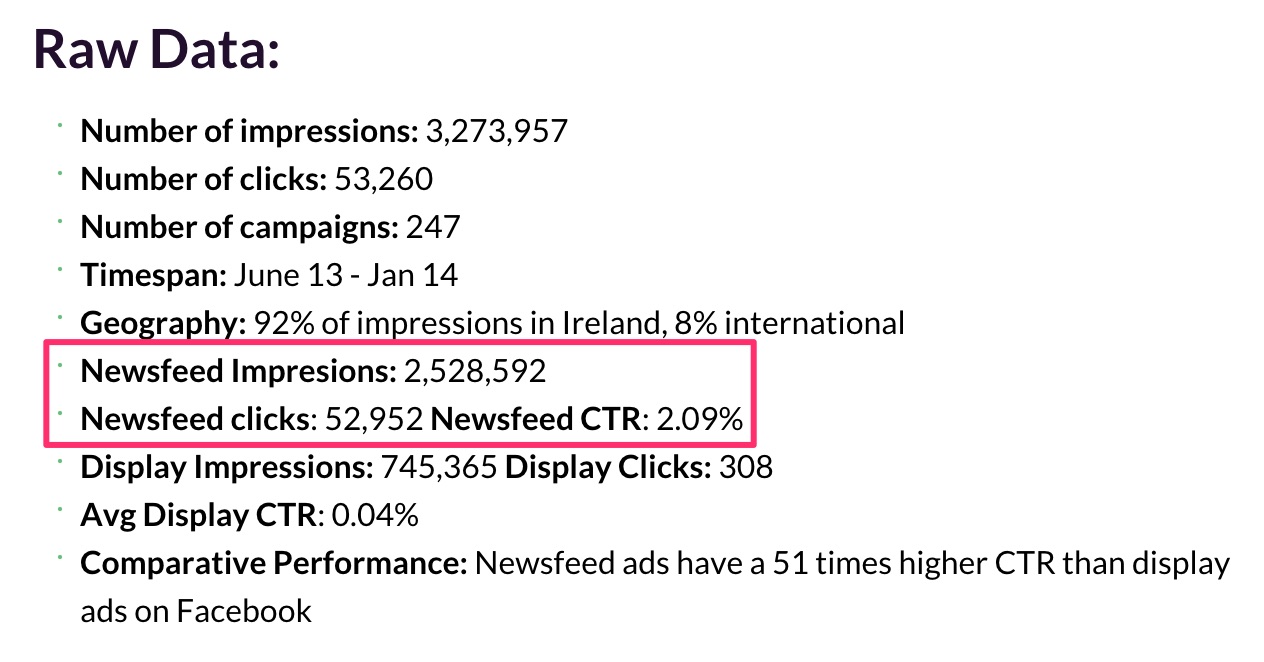
and Quora answers by various professional Facebook advertisers suggests that newsfeed CTRs range from 1% – 3% between desktop and mobile newsfeeds, and anything above a 2.5% CTR is “rocking it.”
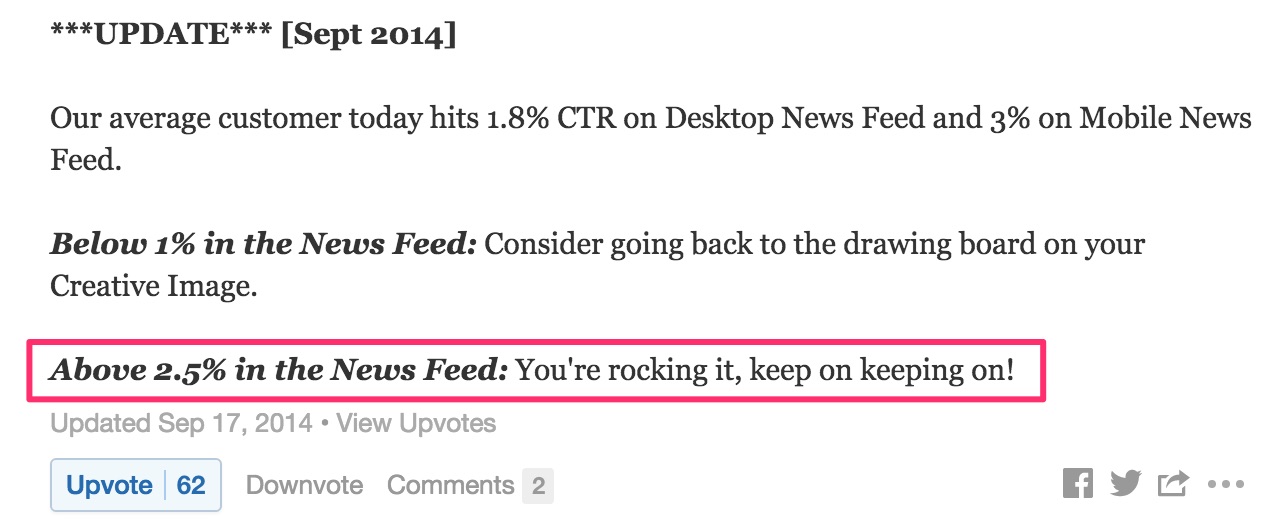
Erika’s campaign is averaging 6.37% CTR on clicks anywhere on the ad and 3.84% on the link to her landing page:

So by all accounts those CTRs are incredible. In other words, she found “ad-market-fit”: her target audience loves her ads. Like I mentioned above, the fact that she’s targeting women with a specific disease and offering a solution to that pain is, I’m sure, critical to this high CTR and low cost per click.
Another metric to mention is reach. A key benefit to uncovering a profitable paid advertising funnel is the ability to keep it running all the time, so your customer acquisition is on autopilot. Of course, anyone who has run ads knows this is not really true. You have to keep monitoring performance as it degrades over time.
Why?
In this case, mostly because of ad fatigue. If you show the same ad to the same people over and over, eventually they stop clicking or engaging with it. Not surprising. You can look for this by observing when your CTR starts dipping and your CPC starts rising. Or in general by looking at frequency: on average how often the ad has been shown to the same person.
Perry Marshall, in his book Ultimate Guide to Facebook Advertising has this table of Facebook ad fatigue rules based on frequency:
- 0 to 3: Very Low Risk
- 3 – 6: Low Risk
- 6 – 9: Moderate Risk
- 9 – 12: High Risk
- 12+: Very High Risk
Erika’s ads, so far, are at a frequency of 2.27 and she’s reached 96,000 of her total audience of 700,000, so she still hasn’t come close to exhausting her audience with this ad. Great news.

So in summary, she’s had over 8,165 people click over to her landing page (depending on who you ask, more on that below) at around $0.06 per click, for a total spend for January to march of $492.01.
The ads have shown to only 14% of her target audience of 700,000. And been shown an average of 2.3 times for each person.
Now let’s see how her funnel has performed once people reach her landing page.
Step 2: Landing Page to Collect Leads
People who clicked on the Facebook ad were taken to this page:
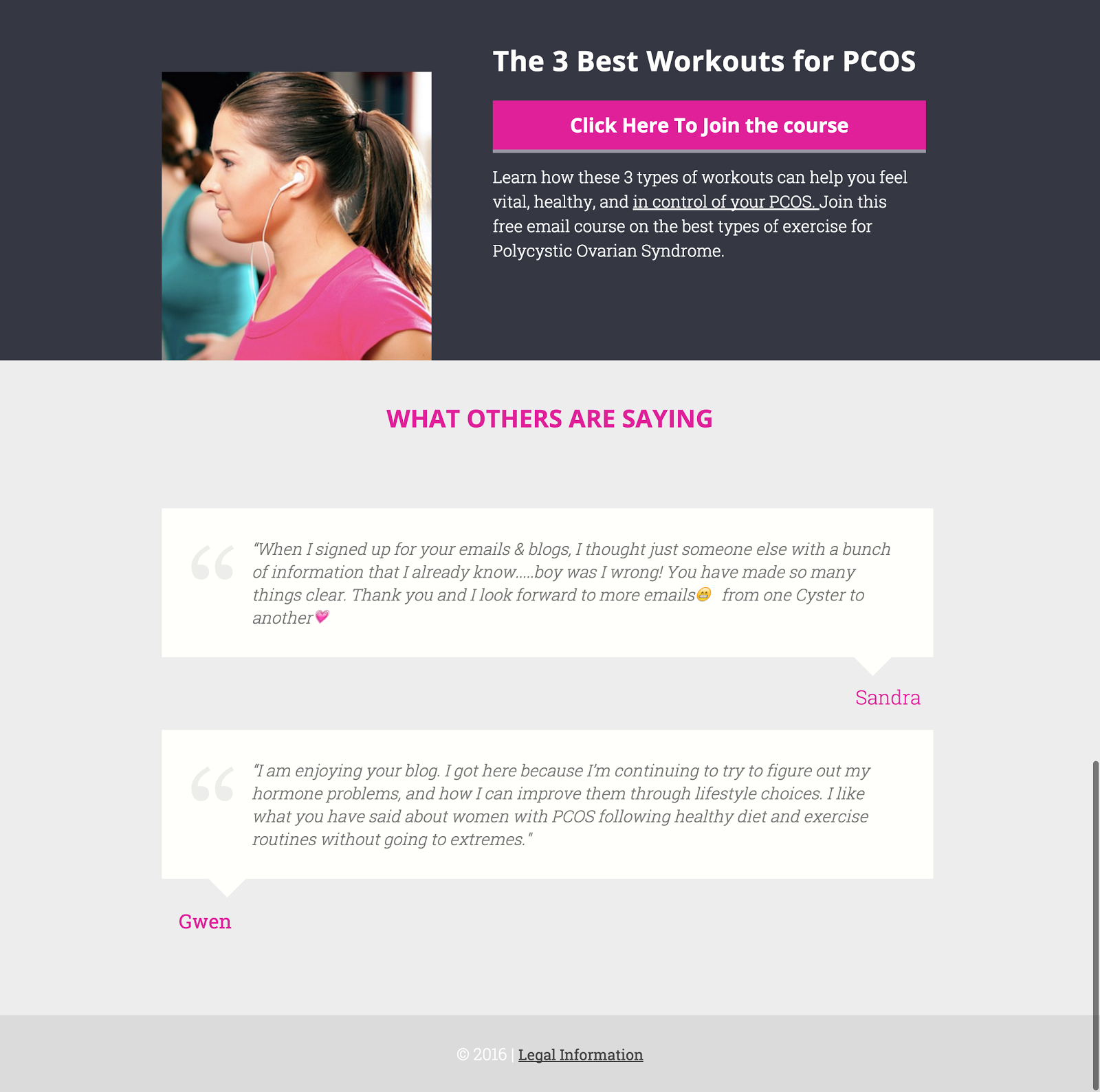
This was made from a LeadPages template and took Erika about 30 minutes.
It’s pretty simple, but qualitatively, it has a few things going for it.
First, it has one (and only one) CTA. Some people send PPC ads to home pages or product pages with a full navbar and a bunch of choices. Erika didn’t make that mistake and sent them to a simple Landing page with only one choice: optin or not.
Second, it has message and design consistency with the Facebook ad. This is a topic all its own and you can read a nice article from ConversionXL about it. Erika has done this well. The visual of the woman working out is the same and the title is (almost) the same.
Third, it has some social proof. Although the testimonials just have first names so it’s unclear how legitimate they are, they are natural, not over the top, and most importantly, they exist.
Quantitatively the LeadPage has been converting at 16%:

That said, I typically see landing pages with simple asks (name, email) convert between 10 – 20%. With 10% being way more common (I can’t think of any 20%+ PPC landing pages I’ve seen off the top of my head).
Finally, recently I tried to create a Facebook to email funnel for a real estate agent and got 40 views on the page without a single optin, and I immediately shut it off. Even if the next click would have converted 1 email out of 41 clicks (2.4%) was way too low for it to work for us financially. Maybe for your business, that’s acceptable.
Landing Page vs. Facebook Ad Stat Differences
Notice that Leadpages says it got 11,850 unique visitors above. If you scroll up you’ll see Facebook says she got 8,395 clicks.
We’re not entirely sure why this is. Surely it’s in Facebook’s financial interest to make sure it counts every last click on the ads since it charges by the click (or in CPM, it wants advertisers to feel like they’re getting as low of a CPC as possible).
Our best guess is that this has to do with the 220 shares of her post that she received:

Once a post is shared, it’s on the sharer’s timeline and further clicks on it aren’t charged to Erika, so she gets those clicks for free (of course, she was charged for the click to share it).
Step 3: The Email Funnel
This step is pretty simple, she simply created the email course that she promised and made sure it was good.
She sent users through an 5 – 8 email autoresponder (she kept experimenting with longer and longer series and has currently settled at 8).
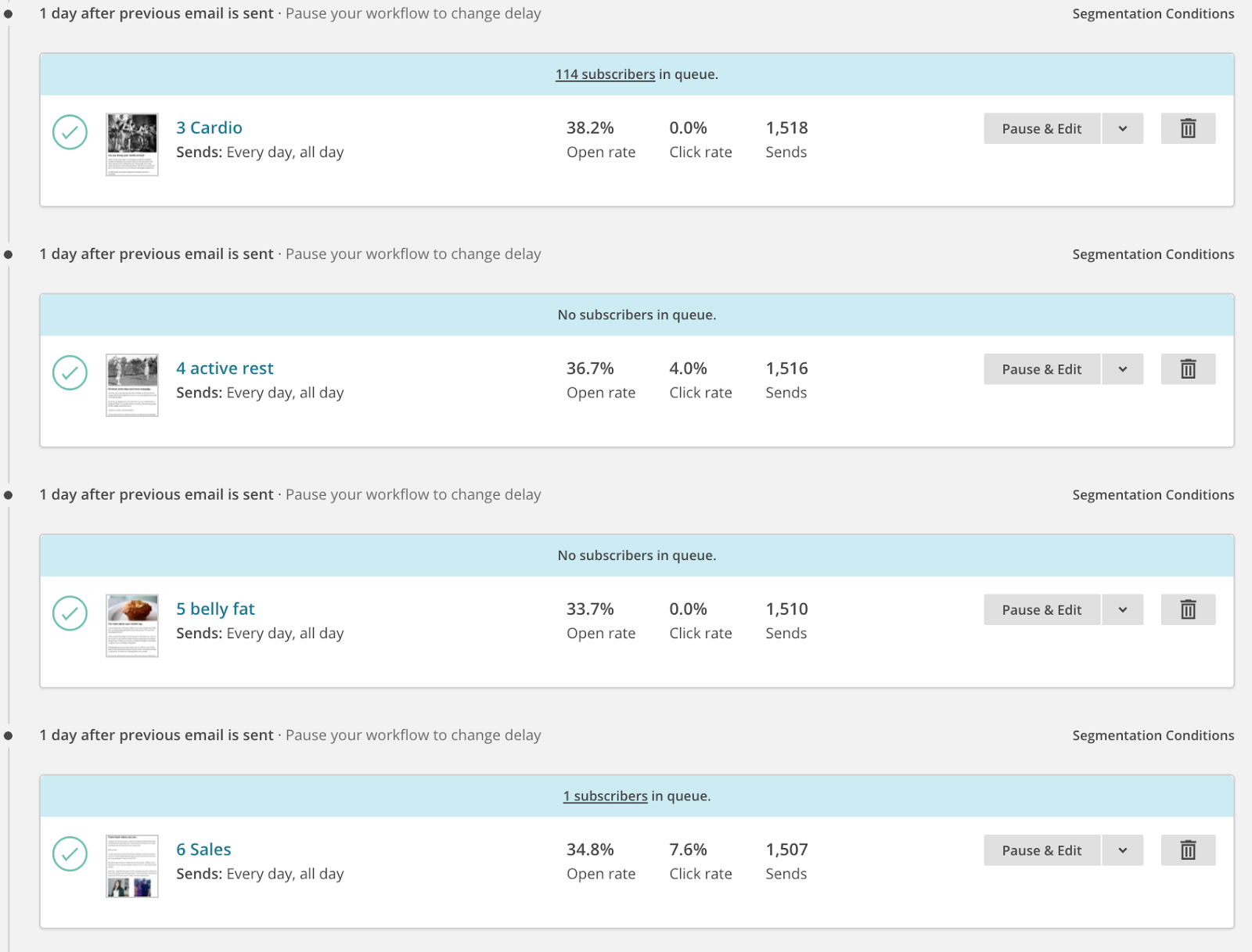
She created these Mailchimp, and they took time. She started from a series she had been using for over a year and she estimates she put in 2 solid days, or 15 additional hours in turning it into this.
But this step should take time, this is where value is being given to your subscribers. If you plan on building enough trust to eventually make an ask, you have to make sure what you’ve given is damn good.
Here’s an excerpt from one of her emails, so you can see the level of detail:
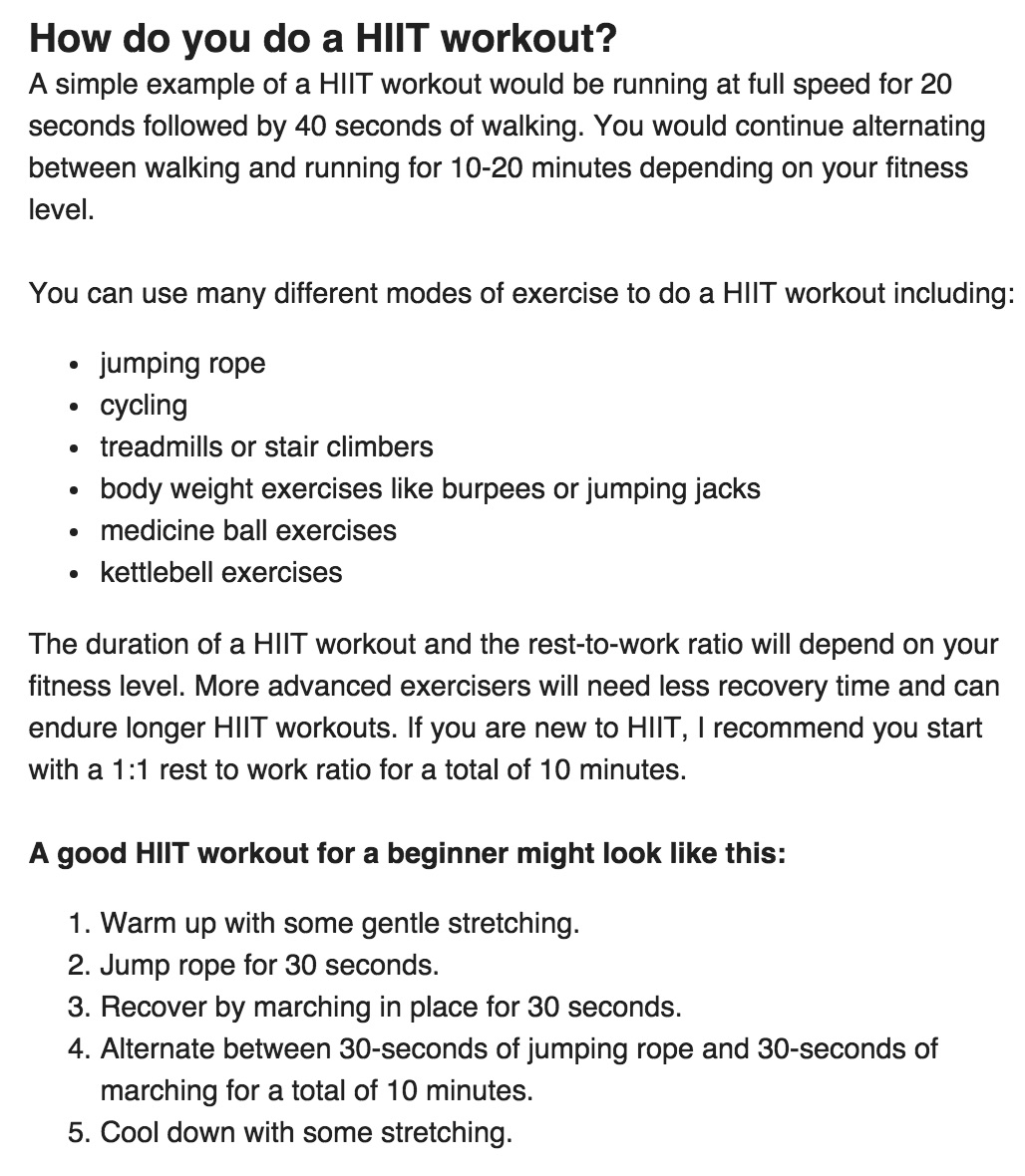
If you’re thinking “Well this doesn’t look extravagant…” Remember this isn’t an email from Old Navy. It’s not meant to razzle dazzle the customer with photos.
Her entire brand is based on a 1-on-1 relationship between her and the reader. So emails are conversational, mostly text, and most important of all actionable. Above she doesn’t just say “HIIT is great, go do it. Here’s a Wikipedia link.” She give them an exact 5 step routine.
The #1 “leadgen” goal in her business is for a lead to take her advice before purchasing anything and see results, so emails like this help tremendously.
Speaking of purchases…now for the fun part, recovering the ad spend by selling product immediately.
Step 4: The paid offers to recover ad cost
Here is how the Facebook ad campaign was (less than) free.
In emails 1, 4 and 6, of her eight email autoresponder, she mentions to the reader that she has some premium workout plans already made and points them to the link. She does it in a non-pushy way and doesn’t really “sell” it until email 6, after they’ve received nearly a week’s worth of value.
Let’s look more closely.
Email 1 – is a welcome email that gets sent immediately after opting in. She shows people her transformation, gets them pumped about the course and says the first lesson will come tomorrow.
But there are always some customers who, after they opt in or take any action with a company (purchase, etc.) are on a high and want more. She gives them a chance to do that here:

The video introduces her “Just Start” Workout program, which is a downloadable PDF and costs only $15.
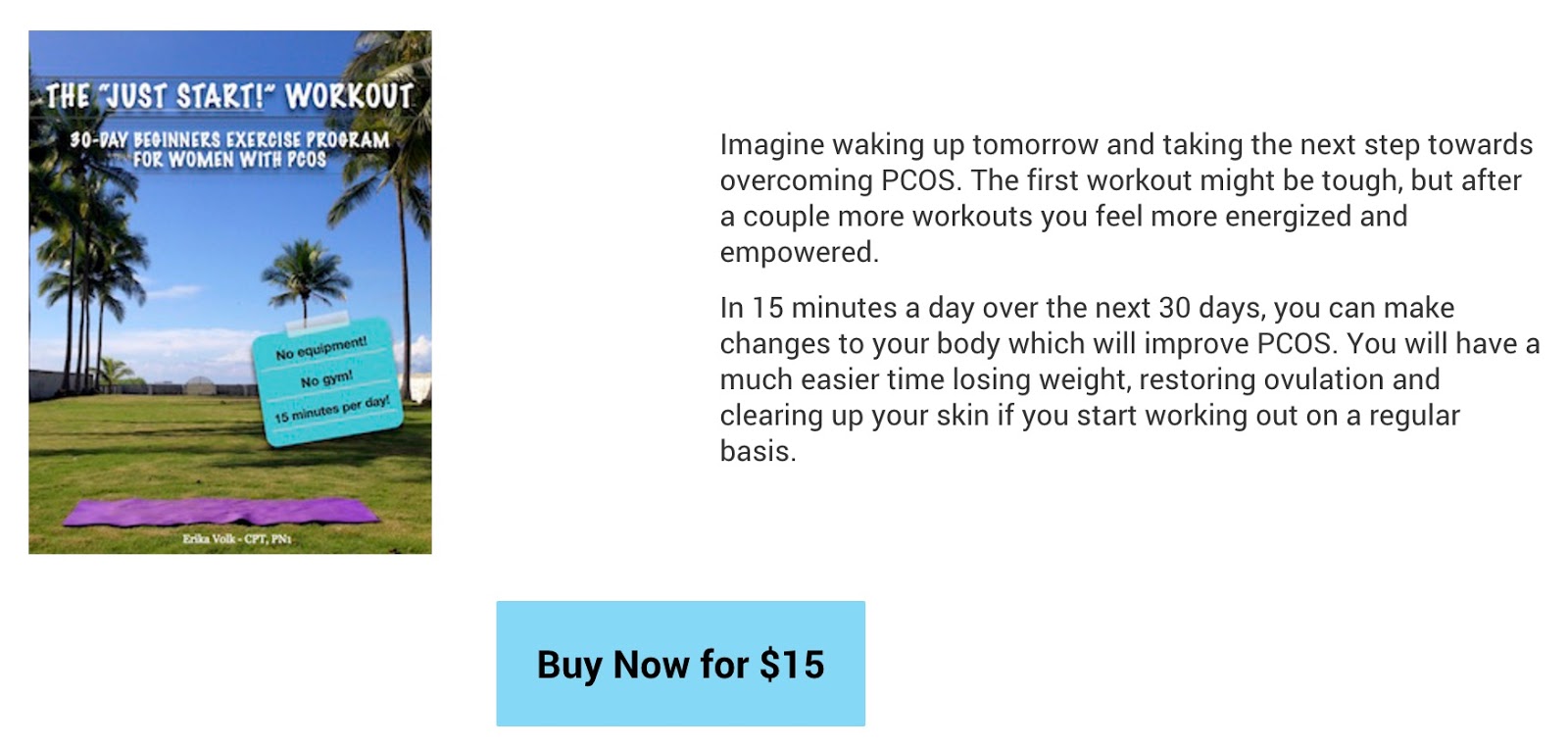
Email 2 – 3 deliver straight value like I showed you above. They make no ask and the customer doesn’t hear about the premium workouts at all. These two emails cover the foundation of her PCOS workout strategy: strength conditioning and cardio.
Email 4 discusses active rest, and how you should orchestrate the week and fit in the workouts outlined in emails 2 and 3. So continuing on that theme, at the bottom of the email, Erika once again gently mentions that she has workouts that “put it all together”:
Email 5 ads more value with a discussion on belly fat – a key pain point of the customer.
Email 6 is the first “hard sell” email. At this point the customer has received almost a week’s worth of lessons with someone finally speaking to them about beating the disease that is affecting their entire life and that they think about every day.
Email 7 then talks about willpower and reminds them of the guide in the PS and Email 8 closes the course.
Overall she has sold $632 dollars of workout programs from the Facebook campaign, $140 more than the $492 she spent while collecting around 2000 email subscribers and over 11,000 unique visitors to her site.
Could this apply to your business?
The reality is, very few (or dare I say, no) strategies work the exact same way for two different businesses. This case study is no different: it may have useful applications for your business or it may not. But that’s your responsibility to decipher, not the person who presented the case study to you. Looking for a plug and play business strategy that requires zero customization is, in our opinion, lazy, and if that’s what you’re looking for, this isn’t the site for you. There are plenty of other sites on the internet that make such promises. This is not one of them.
While working on this case study, I’ve thought a lot about how it may or may not apply to other businesses.
Here is a framework I’ve come up with:
(1) Importance of Lead Collection – Erika Volk Fitness, as a business, has a funnel that relies on building trust by sending a lot of content to the leads and occasionally pitching a product, so lead collection is very important. If on the other hand you’re selling low priced ecommerce goods that are flippant decisions and email subscribers are difficult to monetize, maybe it’s less important.
(2) Cash Flow Restriction – If preserving cash (on the order of what you’d spend on FB ads) isn’t important, than covering your ad spend with a small sale upfront is irrelevant. You might as well just run ads, collect leads, and just minimize your cost per acquisition (CPA) without worrying about making instant sales. But for startups or early bootstrapped businesses, where cash flow is important, this can be a lot more effective.
So for example, if you’re selling a product or service to SMBs that (1) requires nurturing leads and (2) you’re bootstrapping the business, it could be great for acquiring early clients if you found a small product to offer in your nurture sequence that covered ad expense.
On the other hand if you’ve just raised VC money and or you’re rather profitable, it doesn’t matter if you recover the ad spend immediately because you can take the cash hit while you spend time turning the leads into full blown customers.
Here’s a schematic to help visualize what I’m talking about:
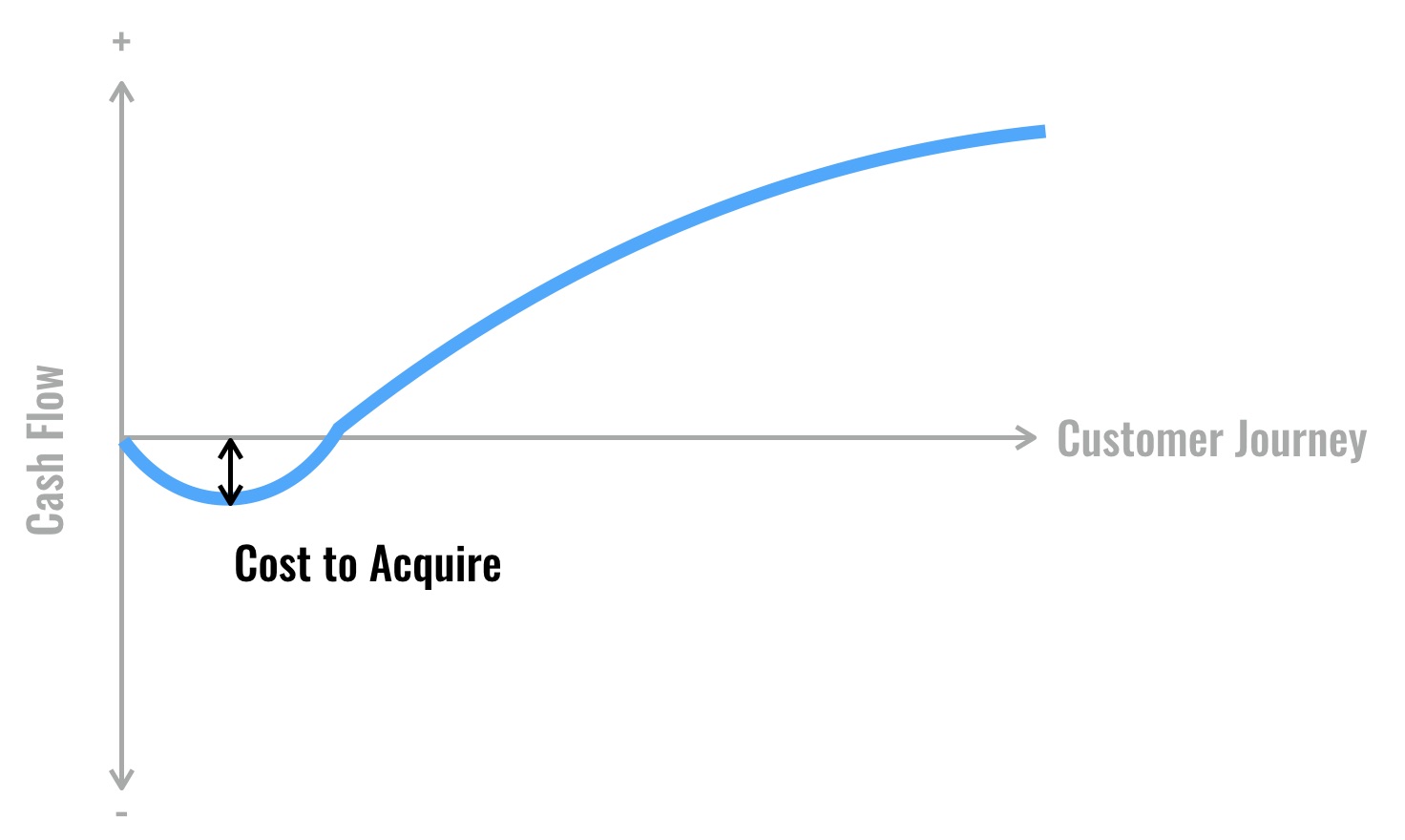
Erika Volk Fitness is a bootstrapped business, so that negative cash flow to acquire customers is very real and covering that in near realtime with early sales helps a lot while she nurtures these leads until she launches major products. No, she’s not going to starve without that $492, that’s not the point. It’s knowing that she can cover FB ad costs if she scales this operation that is a big deal.
For businesses with lots of cash or profitability
The cost to acquire a customer isn’t a big deal if you’ve been given a chunk of VC money or are already profitable. You just funnel that cash or profits into that cost and have plenty of cash left over to keep the lights on as you work your way up that blue curve to profitability.
For businesses with similar smaller priced items (e.g. ecommerce)
Lastly, for businesses that don’t have a “major” product that requires nurturing, this also may not apply. For example, if you’re selling menswear from your newly minted ecommerce store, the shirts and jeans are your final products. There isn’t some “major” sale that you’re waiting to make after you nurture the lead (e.g. a large B2B service contract). In this case you may learn that just sending ad traffic to a category page makes more money in the short and long term versus capturing their email first and nurturing them.
That said, if you’re finding it hard to run ads profitably, but you know that email list subscribers are worth a lot in lifetime value, consider running ads to get people on an email list and offer a tiny upsell for an inexpensive but popular item just to cover the cost of the ad spend.
Questions on whether this applies to you? Ask away in the comments.
———-
Special thanks to William Harris, Growth Marketer at Elumynt.com and Facebook ads afficianado for reviewing this article.
Want us to write an in depth case study or story like this about you or your company? We’ll also drive traffic to it. Apply here.
Like this article? We produce stories like these for our clients, learn more here.

